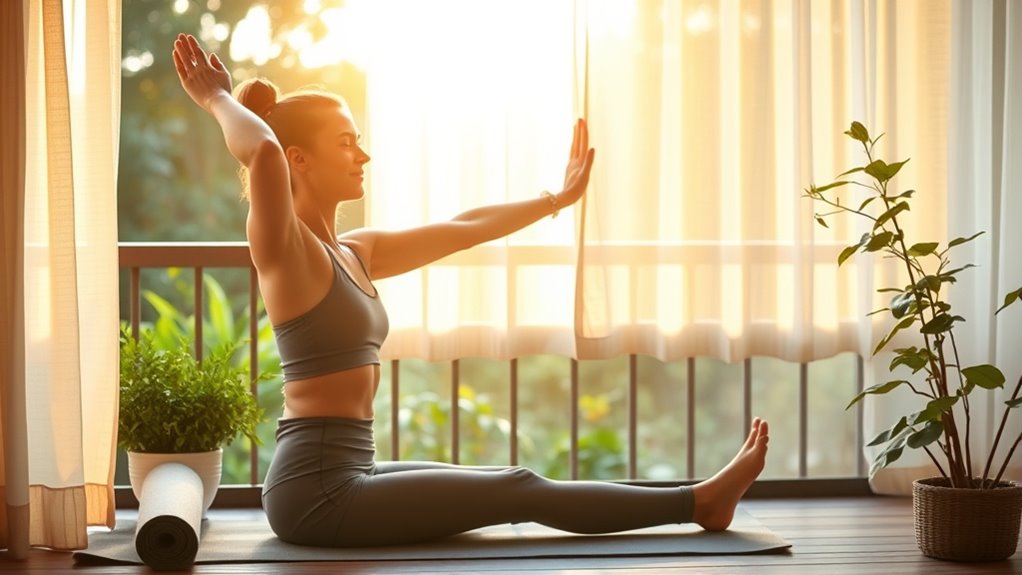Habit Building
Habit Building for Students: Study Routines and Brain Plasticity
Prioritize building study habits through routines and brain plasticity to unlock your full learning potential—discover how consistent effort transforms your academic success.

To build effective study habits, you can leverage brain plasticity by establishing consistent routines that turn learning into an automatic process. Break tasks into manageable steps, set clear goals, and stay motivated by connecting them to your values. Using tools like schedules and reminders helps reinforce these habits daily. Over time, practice rewires your brain to make studying feel natural, making success more achievable—and if you keep at it, you’ll discover how to optimize your learning journey.
Key Takeaways
- Developing consistent study routines leverages brain plasticity, strengthening neural pathways for automatic and efficient learning.
- Effective time management creates structured environments that support habit formation and reduce procrastination.
- Setting clear goals and celebrating progress boosts motivation, reinforcing the habit-building process.
- Repeated, focused practice rewires the brain, making challenging tasks become second nature over time.
- Optimized study environments and routines enhance engagement, making learning more enjoyable and sustainable.

Have you ever wondered why some students excel while others struggle to stay on track? The answer often boils down to habits—specifically, how you manage your time and stay motivated. Building effective study routines isn’t just about hitting the books; it’s about creating a sustainable system that leverages your brain’s ability to adapt and grow, thanks to brain plasticity. When you develop good habits, you’re conditioning your brain to perform tasks more efficiently over time, making learning feel less like a chore and more like a natural part of your day.
Developing good habits rewires your brain for efficient, natural learning and sustained academic success.
Time management plays a vital role in establishing these habits. If you don’t plan your day wisely, it’s easy to get overwhelmed or distracted, which hampers your progress. By allocating specific blocks of time for studying, breaks, and other activities, you create a structured environment that minimizes procrastination. Using tools like calendars, to-do lists, or digital reminders helps keep you accountable. When you stick to a routine, your brain begins to associate certain times with focused work, gradually reducing the effort needed to start studying. This consistency helps embed your study habits into your daily life, making them feel automatic rather than burdensome.
Motivation strategies are equally important because they keep you engaged and committed. When you set clear, achievable goals, you give yourself a sense of purpose and direction. Celebrate small wins, like completing a chapter or understanding a difficult concept, to boost your confidence. Reminding yourself of the bigger picture—your long-term goals—can also fuel your determination when your enthusiasm dips. Creating a positive study environment, like listening to motivating music or studying with friends, can reinforce good habits and make studying more enjoyable. The key is to connect your habits to your personal values and aspirations, so that the routine becomes intrinsically rewarding rather than just a chore.
Your brain is incredibly adaptable, especially during your student years, thanks to brain plasticity. The more you practice a habit, the stronger the neural pathways become, making the behavior more automatic over time. This means that with consistent effort, even difficult tasks can become second nature. When you combine effective time management with strong motivation strategies, you’re not just doing tasks—you’re rewiring your brain for success. Additionally, understanding the importance of projector image quality can be likened to optimizing your study environment; just as a clear picture enhances viewing, a well-structured routine enhances learning efficiency. Over time, these habits will support your academic performance and help you develop skills that serve you beyond school.
In essence, building solid study habits is about creating a balanced system that taps into your brain’s capacity to change. By managing your time wisely and keeping yourself motivated, you set yourself up for sustained success and make your learning journey smoother and more fulfilling.
Frequently Asked Questions
How Long Does It Take to Form a New Study Habit?
It generally takes about 21 to 66 days to form a new study habit, depending on your consistency and motivation strategies. Staying consistent with your study routine is key; the more you practice, the faster the habit becomes automatic. Keep your motivation high by setting clear goals and rewarding yourself. Remember, the more persistent you are, the sooner your new study habit will become a natural part of your routine.
Can Brain Plasticity Improve Memory Retention in Students?
The proof is in the pudding—brain plasticity can definitely improve your memory retention. By engaging neuroplasticity mechanisms, you strengthen neural pathways, making it easier to consolidate memories. When you actively review and practice, you enhance your brain’s ability to adapt, leading to better retention over time. So, keep challenging yourself, and your brain will become a more efficient memory machine through ongoing neuroplasticity and memory consolidation processes.
What Are the Best Times of Day for Studying?
The best times of day for studying depend on your personal rhythm, but generally, morning and early evening are ideal study times. Morning focus tends to be sharper after rest, helping you retain new information better. Evening can work if you’re a night owl, but focus might decline. Experiment with both to find when your brain is most alert, and prioritize studying during those prime times for improved retention.
How Do Stress Levels Affect Habit Formation and Brain Flexibility?
You might notice that when stress levels spike, your ability to form habits and stay flexible diminishes. Stress management and mindfulness techniques can help you stay calm, making it easier to develop routines and boost brain plasticity. By practicing deep breathing or meditation regularly, you create a mental space that supports habit formation, allowing your brain to adapt and learn more effectively, even during busy or stressful times.
Are There Specific Foods That Enhance Brain Plasticity for Students?
You can boost your brain plasticity by eating brain boosting foods like fatty fish, blueberries, nuts, and dark leafy greens. These foods provide essential nutrients that support cognition and improve your ability to learn new habits. Prioritize good nutrition for cognition daily, as it enhances your focus and memory, making it easier to establish and maintain effective study routines. Proper nutrition is a key part of developing healthier habits.
Conclusion
So, congratulations—you’re now a habit-building superstar! Just remember, sticking to those study routines might feel like trying to tame a wild squirrel, but with a little brain plasticity magic, you’ll soon be a studying ninja. Who knew that rewiring your brain could be this fun? Keep at it, and soon your future self will thank you for turning those tiny habits into mighty success. Now go conquer those textbooks—your brain’s ready!
Habit Building
Creating Keystone Work Habits: Productivity Anchors for Professionals
Discover how developing keystone work habits can transform your productivity and why these routines are essential for lasting success.

To create keystone work habits, focus on establishing routines that act as productivity anchors. Start by setting clear goals and breaking them into manageable steps, then allocate dedicated time blocks to high-priority tasks. Build consistent routines like morning planning and automation of small actions to reduce mental clutter. These habits create a ripple effect, making your entire workflow smoother and more focused. Keep exploring to discover how to develop these powerful routines for lasting success.
Key Takeaways
- Establish daily routines that prioritize high-impact tasks to create a steady productivity foundation.
- Allocate specific time blocks for planning, goal setting, and reflection to reinforce focus and progress.
- Automate small, consistent actions to reduce decision fatigue and build momentum over time.
- Use deliberate start-of-day rituals to set a clear, confident mindset for sustained work.
- Incorporate energizing techniques like mindful breaks to maintain focus and support overall productivity.

Have you ever wondered why some habits seem to ripple positively through every aspect of your work while others barely stick? The truth is, certain core routines—often called keystone habits—serve as powerful anchors that shape your overall productivity. When you develop a keystone habit, it creates a ripple effect, making other tasks easier and more efficient. One of the most effective keystone habits is mastering your time management. By consistently allocating specific blocks of time to important activities, you create a structure that naturally supports your goals. Instead of reacting to every distraction, you proactively set boundaries around your work hours, which helps you stay focused and execute tasks more efficiently. This discipline in managing your time directly influences your ability to set and achieve meaningful goals. When your schedule is well-organized, you can prioritize high-impact activities, making goal setting more straightforward and actionable. It’s easier to break down long-term objectives into smaller, manageable steps when you have a clear timeline in place. As you develop these routines, you begin to see how they reinforce each other—time management fuels your goal setting, and clear goals give your time management purpose. This interconnectedness creates a sustainable cycle where each habit strengthens the other. Additionally, incorporating nutrient retention techniques like mindful juicing can boost your overall energy and focus, further supporting your productivity. Focusing on keystone habits also means recognizing the importance of intentionality. When you start your day with a specific plan—perhaps reviewing your goals or outlining your priorities—you set a tone that carries through your entire work session. This habit reduces the mental clutter of indecision, allowing you to stay engaged and productive. Over time, these small, deliberate actions become automatic, freeing up mental energy for more complex tasks and creative problem-solving. As your routines solidify, you’ll notice a shift in your mindset; you’ll approach work with greater confidence and clarity. The key is consistency. Even if some days are more challenging than others, sticking to your routines builds resilience and momentum. The more you practice these foundational habits, the more they become embedded in your daily workflow, creating a reliable framework that supports your professional growth. Ultimately, the power of keystone habits lies in their ability to foster a sense of control and purpose, helping you navigate your workload with greater ease and effectiveness.
Frequently Asked Questions
How Long Does It Take to Establish a New Keystone Habit?
It usually takes about 21 to 66 days to establish a new keystone habit, but this varies due to habit formation and consistency challenges. You might find it takes longer if you struggle with maintaining regularity or face distractions. The key is to stay committed and practice daily, even when it feels difficult. Over time, your new habit will become automatic, helping you boost productivity and create positive routines.
Can Keystone Habits Be Adjusted Over Time for Better Results?
Did you know that 45% of habits are adjusted within the first year? Yes, keystone habits can definitely be adjusted over time for better results. By practicing habit evolution, you stay adaptable and improve your routines. Incorporate flexibility strategies like periodic reviews and tweaks to your habits. This way, you optimize your productivity, ensuring your keystone habits grow with your needs and lead to sustained success.
What Are Common Obstacles When Implementing Productivity Anchors?
When implementing productivity anchors, you often face obstacles like distraction management and motivation challenges. Distractions can pull you away from your routines, making it tough to stay consistent. Motivation dips may cause you to skip key habits, reducing their effectiveness. To overcome these, you need to set clear boundaries, find sources of inspiration, and remind yourself of your goals. Staying disciplined and adaptable helps you navigate these common hurdles successfully.
How Do Keystone Habits Differ Across Various Industries?
Ironically, industry-specific routines often seem like universal truths, but they’re tailored to role-based anchors that differ wildly across sectors. For example, a healthcare professional relies on quick, precise decision-making, while a software developer emphasizes deep work sessions. Your keystone habits must adapt to these unique demands, making role-based anchors essential. Recognizing these differences helps you craft effective, industry-specific routines that truly boost your productivity.
What Tools Best Support Maintaining Consistent Work Habits?
You can stay consistent with your work habits using digital tools like task managers, calendar apps, and habit-tracking software to keep you organized and on track. Additionally, accountability partners provide motivation and support, helping you stay committed to your routines. Combining these tools guarantees you remain focused, disciplined, and productive, making it easier to develop and sustain keystone habits that boost your overall work performance.
Conclusion
By establishing keystone work habits, you set the foundation for lasting productivity, much like a sturdy tree supports its branches. These habits become your anchors, guiding you through busy days and unforeseen challenges. Keep consistency at the forefront, and you’ll find your workday flows smoother—like a well-oiled machine. Remember, small changes today can lead to big results tomorrow. Stay committed, and watch your professional life flourish like a garden in full bloom.
Habit Building
Habit Tracking Apps Compared: Features That Keep You Consistent
Discover how habit tracking apps use engaging features to help you stay consistent—find out which ones stand out and why you should keep reading.
To stay consistent with habit tracking apps, look for those that combine engaging gamification features like rewards, streaks, and levels with customizable options such as reminders, goal setting, and visual themes. These apps make habit-building fun and tailored to your routine, boosting motivation and long-term adherence. By integrating these elements, you create an enjoyable, personalized experience that encourages continued use. Stay with us to discover how the best apps leverage these features for ultimate success.
Key Takeaways
- Effective habit tracking apps combine gamification with rewards, streaks, and levels to boost user engagement and motivation.
- Customization options like personalized reminders, themes, and goal settings enhance adherence and long-term commitment.
- Multiple tracking methods such as checklists, streak counters, and analytics provide tailored visualizations for user preferences.
- Integrating gamification with customization creates an engaging, rewarding experience that sustains motivation and promotes consistent habit formation.
- The best apps seamlessly blend features to make habit tracking enjoyable, helping users achieve their goals more effectively over time.
Have you ever struggled to build new habits or stay consistent with your goals? If so, you’re not alone. Many people find it tough to maintain motivation and track progress over time. That’s where habit tracking apps come in, offering tools designed to boost your consistency and make habit formation feel engaging. When choosing an app, one of the key features to look for is the incorporation of gamification strategies. These strategies turn your habit-forming journey into a game-like experience, complete with rewards, streaks, and levels that motivate you to keep going. For example, earning points or revealing achievements for consecutive days of practice can make sticking to new routines feel rewarding rather than burdensome. Gamification taps into your natural desire for achievement, turning effort into a fun challenge rather than a chore.
Another vital aspect is customization options. No two habits are the same, and your approach to building them shouldn’t be either. The best habit tracking apps let you tailor your experience by allowing you to set personalized reminders, adjust the frequency of notifications, or choose specific goals that align with your lifestyle. Customization ensures that the app adapts to your unique routines and preferences, increasing the likelihood that you’ll stick with your habits long-term. For instance, if you’re trying to exercise more, you might set specific workout times or select different types of activities to keep things interesting. Some apps even let you customize visual themes, progress charts, or the way you log your habits, making the experience more personal and engaging.
Moreover, these customization options often extend to tracking methods. You might prefer simple checklists, streak counters, or detailed analytics—many apps provide multiple ways to visualize your progress. When you have control over how you monitor your habits, you’re more likely to stay committed because it feels tailored to your needs. Coupled with gamification strategies, this makes the process enjoyable rather than tedious. You’ll find yourself looking forward to checking your progress or earning that next reward, reinforcing positive behavior. Ultimately, the best habit tracking apps combine these features seamlessly, giving you a personalized, motivating experience that helps you build consistency and achieve your goals more effectively.
Frequently Asked Questions
How Do Habit Tracking Apps Impact Long-Term Behavior Change?
Habit tracking apps positively impact your long-term behavior change by providing consistent behavior reinforcement and boosting motivation strategies. They help you visualize progress, encouraging you to stay committed. By setting achievable goals and receiving regular reminders, you stay motivated and focused. Over time, this reinforcement solidifies habits, making positive behaviors automatic. These apps become essential tools, transforming your intentions into lasting actions through continuous engagement and support.
Are There Free Habit Tracking Apps With Premium Features?
Imagine you’re starting a new habit; a free option like Habitica offers basic tracking to keep you motivated. Many apps, including this one, provide free options with premium features like advanced analytics or customization. Typically, you can try premium features through free trials or purchase them as needed. This allows you to enjoy core functionality without cost while accessing additional tools to boost your consistency when you’re ready.
Can Habit Apps Integrate With Other Health or Productivity Tools?
Many habit apps now integrate with other health or productivity tools, enhancing your experience. You can sync data with fitness trackers, calendar apps, or note-taking tools, making your routine seamless. Just verify the app prioritizes data privacy and offers good app compatibility. This way, you stay consistent without worrying about data security, and you enjoy smooth integrations that fit your lifestyle and goals effortlessly.
What Privacy Considerations Exist When Using Habit Tracking Apps?
Oh, privacy—what a charming illusion! When you use habit tracking apps, you might think your secrets are safe, but beware: data sharing lurks in the shadows, and data encryption isn’t always foolproof. You’re practically handing over your routines and personal info on a silver platter. Always check privacy policies, control your permissions, and remember—your habits shouldn’t become open books, even if the app promises to keep your data locked tight.
How Do Habit Tracking Apps Accommodate Different Learning Styles?
Habit tracking apps accommodate different learning styles by offering features for visual learners, like charts and colorful progress graphs, making progress easy to see. For kinesthetic engagement, some apps include interactive elements such as tapping, swiping, or setting physical reminders. You can tailor notifications and visuals to match your preferred learning style, helping you stay motivated and consistent while making habit formation more engaging and personalized.
Conclusion
Choosing the right habit tracking app can feel like a coincidence, but it’s really about finding what keeps you motivated. When you pick a app that aligns with your goals and makes consistency easy, you’ll notice your habits stick better than ever. Sometimes, the smallest feature—like a reminder or visual progress—can make all the difference. So, trust your instincts, experiment a little, and see how the right app naturally becomes your secret weapon for success.
Habit Building
Habit Stacking for Mental Health: Pair Mindfulness With Movement
A simple habit stacking technique can transform your mental health, but discovering how to effectively pair mindfulness with movement will change everything.

To boost your mental health, try habit stacking by pairing mindfulness with movement throughout your day. You can do simple activities like mindful stretching, walking, or even during routine chores, focusing on your breath and bodily sensations. These small, manageable actions gradually build resilience, reduce stress, and improve focus. By consistently combining movement and mindfulness, you turn everyday moments into opportunities for calm and clarity—keep going to discover how to seamlessly incorporate this into your routine.
Key Takeaways
- Combine small movements like stretching or walking with mindfulness practices to promote mental calmness and physical health.
- Use routine activities, such as commuting or meal prep, to incorporate brief mindfulness moments easily.
- Focus on breath awareness and body sensations during movement to enhance emotional resilience and reduce stress.
- Gradually build habits by stacking mindful pauses onto existing daily actions for sustainable mental health benefits.
- Consistent pairing of movement and mindfulness creates long-term resilience, clarity, and emotional well-being.

If you want to improve your mental health without overhauling your daily routine, habit stacking offers a simple and effective strategy. By pairing small, manageable actions, you can build positive habits that support your well-being over time. One powerful approach involves combining mindfulness techniques with physical activity, creating a sustainable way to boost your mental clarity and emotional resilience. This pairing not only enhances your mood but also reinforces your ability to stay present and focused throughout the day.
When you integrate mindfulness techniques into your physical activity, you turn routine movement into an opportunity for mental grounding. For example, as you walk or stretch, you can focus on your breath, paying attention to each inhale and exhale. This practice helps you stay in the moment, reducing stress and anxiety. The physical activity benefits are amplified because movement naturally releases endorphins, the body’s feel-good chemicals, which improve your overall mood. Moving intentionally while practicing mindfulness creates a dual benefit: your body gets the physical benefits of exercise, and your mind gains clarity and calmness.
You don’t need to dedicate hours or to learn complicated techniques. Starting small, like taking a five-minute walk while focusing on your surroundings or doing gentle stretches while observing your breath, makes the process approachable. Over time, these small habits stack up, forming a routine that’s both easy to maintain and highly effective. The key is consistency—by linking mindfulness to activities you already do regularly, such as commuting or preparing meals, you can turn everyday moments into opportunities for mental health support.
This method also helps you develop a deeper awareness of your body and mind, which is central to many mindfulness techniques. As you become more attuned to your physical sensations and emotions during movement, you train your brain to respond more calmly to stressors. Additionally, understanding the importance of contrast ratio in visual clarity can deepen your appreciation for clarity and focus, both in your environment and within yourself. The physical activity benefits extend beyond mood enhancement; regular movement has been linked to better sleep, increased energy levels, and reduced symptoms of depression and anxiety. When you consciously pair mindfulness with movement, you create a cycle of positive reinforcement that fosters resilience and emotional stability.
Incorporating this habit stacking approach doesn’t require radical changes. You simply add mindfulness to movements you already do—like during your morning stretch or while waiting for your coffee to brew. Over time, these small adjustments can lead to significant improvements in your mental health. By consistently pairing mindfulness techniques with physical activity, you’re nurturing a more balanced, grounded you—one mindful moment at a time.
Frequently Asked Questions
How Long Should Each Mindfulness and Movement Session Last?
For habit consistency, aim for each mindfulness and movement session to last about 10 to 15 minutes. This duration is enough to reap mental health benefits without feeling overwhelming. If you’re new, start with shorter sessions and gradually increase as you build the habit. Consistency is key, so find a timeframe that fits into your daily routine, making it easier to stick with your habit over the long term.
Can Habit Stacking Work for Severe Mental Health Issues?
Habit stacking can help manage severe mental health issues, but severity considerations matter. You should work closely with a mental health professional to guarantee these routines complement therapy integration. While stacking habits like mindfulness and movement can boost your overall well-being, they shouldn’t replace treatment. Consistent, tailored efforts may improve your condition, but always prioritize professional guidance for severe challenges.
What if I Forget to Pair Mindfulness With Movement?
If you forget to pair mindfulness with movement, don’t worry. You can use mindfulness reminders or movement cues to help you remember. Set alarms or place sticky notes as visual prompts, and create specific triggers like starting your walk with a deep breath or a quick mindful check-in. Over time, these cues will become automatic, making it easier to integrate mindfulness and movement seamlessly into your routine.
Are There Specific Movements Best for Mental Health?
Surprisingly, not all movements are created equal for mental health. The best ones are gentle stretches and breathing exercises, which help calm your mind and reduce stress. Think slow, mindful movements that focus on your breath—like neck rolls, shoulder stretches, or deep breathing. These simple actions can boost your mood and mental clarity, proving that sometimes, the smallest movements pack the biggest mental health punch.
How Quickly Can I Expect to See Benefits From Habit Stacking?
You can start noticing benefits from habit stacking within a few weeks, but timing expectations vary based on consistency. As you consistently pair mindfulness with movement, observe progress indicators like improved mood, reduced stress, and increased energy. Keep in mind, regular practice enhances mental health gradually, so stay patient and committed. Over time, these small habits build up, leading to meaningful improvements in your overall well-being.
Conclusion
By stacking habits like mindfulness with movement, you’re weaving a vibrant tapestry of resilience and calm. Each small act becomes a brushstroke, painting a brighter, more resilient you. When these habits intertwine, they form a steady heartbeat—an anchor in life’s chaos. Embrace this gentle dance, and watch your mental health bloom like a resilient garden, rooted in care and consistency. Your journey to well-being starts now—one mindful step at a time.
-

 Wish Notes1 year ago
Wish Notes1 year agoBest Caption to Wish Myself a Happy Birthday That Everyone Will Like!
-

 Wish Notes1 year ago
Wish Notes1 year agoThe Best Birthday Wishes to Make Your Uncle's Day Bright!
-

 Wish Notes1 year ago
Wish Notes1 year agoThe Sweetest Happy Birthday Wishes for Your Wife!
-

 Wish Notes1 year ago
Wish Notes1 year agoThe Best Happy Birthday Wish for Your Brother That Will Make Him Smile!
-

 Wish Notes1 year ago
Wish Notes1 year agoHeartwarming Birthday Messages for Mom in Spanish
-

 Wish Notes1 year ago
Wish Notes1 year agoThe Best Happy Birthday Wishes for Your Husband That Will Make His Day!
-

 Wish Notes1 year ago
Wish Notes1 year agoThe Ultimate Birthday Wishes to Celebrate Yourself!
-

 Wish Notes1 year ago
Wish Notes1 year agoThe Most Heartfelt Good Night Wishes Ever!










